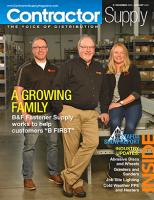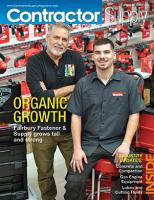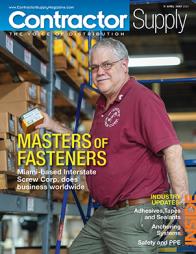Equipment security: From under your nose
Stolen asset recovery systems offer hope for equipment owners.
By Courtney DeMilio
The growth rate in construction industry spending will reach double digits in 2014 and 2015, with construction and industrial equipment rental revenue expected to reach $30.9 billion in 2017, according to the American Rental Association’s Rental Market Monitor, compiled by the economic research firm IHS Global Insight.
|
The National Insurance Crime Bureau estimated in October 2012, that from $300 million to close to $1 billion each year is lost nationwide due to theft of construction equipment and tools. |
This increased demand for construction work means that the demand for construction equipment and tools, either purchased or rented, will increase not only from paying customers but also from construction equipment thieves looking to take advantage of this market uptick.
As a result, every owner of commercial construction equipment should take the threat of equipment theft seriously and implement proactive steps to protect their financial investments in their equipment. Contractor supply distributors and equipment manufacturers can help their customers by offering stolen asset recovery systems.
The National Insurance Crime Bureau (NICB), compiling data from multiple sources, estimated in October 2012, that from $300 million to close to $1 billion each year is lost nationwide due to theft of construction equipment and tools. (The
National Equipment Register examines detailed theft reports from a specific area that accurately reports theft — such as a fleet, industry or region — to make assumptions and develop trends. Then the NICB applies those trends to the entire market share of that specific area to build a national figure.)
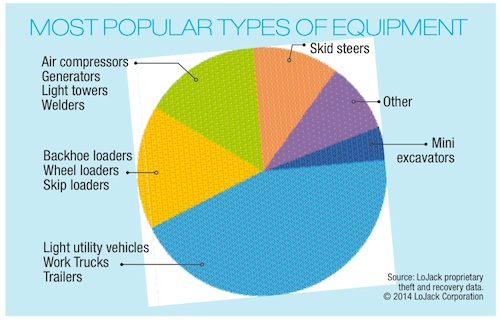 |
|
As ranked by frequency of theft in 2013, light utility vehicles, work trucks and trailers topped the 2013 LoJack Corporation Study on Construction Equipment Theft. Backhoes and wheel loaders were second and generators, air compressors, welders and light towers came in third. |
Since most equipment owners and equipment rental companies are self-insured, they take a heavy financial blow when even one piece of their construction equipment is stolen. In addition, cost ramifications for heavy equipment renters — when rental equipment is stolen on their “watch,” — can range from business downtime and insurance deductibles to having to replace the piece of equipment. Such costs might put smaller contractors out of business.
Generators, aircompressors, welders and light towers are popular targets for theft because they are versatile pieces of equipment, have high rental demands, are easily attached to any trailer hitch and can easily be used on a wide variety of job sites and/or be resold by thieves to unsuspecting buyers. Since these towable items are part of any national emergency first response, they are very vulnerable to theft in all geographies.
The fact that construction equipment is not titled or registered — machines have Product Identification Numbers rather than the automotive standard 17-digit Vehicle Identification Number — is another factor facilitating theft and resale of such equipment. For this reason, skid-steers, forklifts, mini excavators and backhoes are not only among the top items stolen, but they are not easy to identify by police. Not having a license plate to easily scan makes the task of routine checking on suspicious activity a challenge even for highly-trained law enforcement officers.
Generators, air compressors and welders were ranked as the third highest type of equipment to be stolen by thieves — as ranked by frequency of theft in 2013,
according to The 2013 LoJack Corporation Study on Construction Equipment Theft. This study is based on state theft statistics and recoveries documented by LoJack in 27 states from January to December 2013.
In addition, the new and often more costly “Tier 4” versions now coming onto job sites are even more attractive to thieves. The U.S. Environmental Protection Agency’s Tier 4 engine emissions rule — which includes requirements for exhaust gas recirculation (EGR) and the use of ultra-low sulfur diesel fuel to improve air quality — has substantially increased the financial value of this equipment.
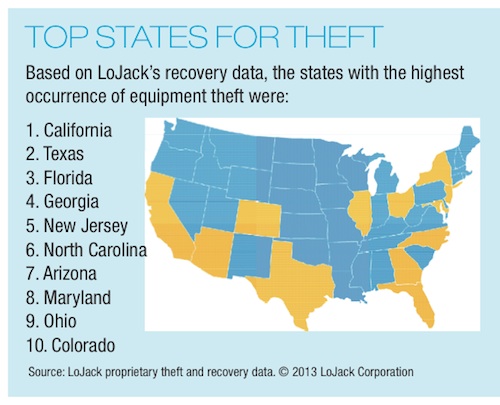 |
|
Equipment theft and recovery is highest in states with healthy construction markets and those with an international border or access to major shipping ports. In almost 95 percent of recovery cases, stolen quipment was recovered in the same state in which it was reported stolen — either in storage or in use on another job site. |
Contractor supply distributors and manufacturers of construction equipment can help their customers protect their investments in heavy equipment and heavy-duty on-road and off-road vehicles by adding stolen asset recovery systems, such as the LoJack Stolen Vehicle & Construction Equipment Recovery System, to their offerings.
LoJack Corporation has developed the self-powered, ruggedized LoJack Stolen Vehicle & Construction Equipment Recovery System exclusively for construction equipment and heavy-duty commercial vehicles.
Unlike GPS systems, the LoJack system radio-frequency signal can be tracked through concrete and steel, making it possible to find the stolen equipment with an activated LoJack System even if that piece of heavy equipment is hidden in or behind concrete buildings or garages, or in steel containers at shipping ports bound for overseas buyers.
The LoJack system is covertly installed on each piece of heavy equipment by a LoJack certified technician; even the equipment owners and construction workers on the job site do not know where it is located on the equipment. This covert installation makes it difficult and time-consuming for thieves to try to find and disarm the LoJack system.
Unlike other systems, the LoJack system is directly integrated with law enforcement. Once a vehicle is reported and processed by the police as stolen, the LoJack system in that vehicle emits a uniquely coded radio signal. LoJack system unit activation is contingent on the vehicle being located within LoJack’s coverage area that spans counties across 29 states throughout the U.S.
Typically, heavy equipment rigged with a LoJack system can be recovered by law enforcement within twenty-four hours of it being reported stolen — before thieves have sufficient time to damage, dismantle or ship the equipment and resell it to buyers nearby or far away.
Here are just a few recent examples of the speedy recovery of stolen assets with the aid of the LoJack system and law enforcement:
Workers at a construction site in Irving, Texas, may have thought someone was playing an April Fool’s Day joke when they discovered their rented Sullivan air compressor was missing, April 1, 2014. But, that was not the case. The owners of the rented machine — who had equipped their asset with the LoJack system — reported the air compressor stolen that day to the Irving Police Department.
Irving Police Officers verified the theft and entered the machine’s information into the state and federal crime computers, which automatically activated the LoJack transponder concealed in the air compressor.
A short while later, deputies from the Fort Bend, Texas Sheriff’s Office picked up the silent homing signals from the stolen machine on their LoJack tracking computers installed in their patrol vehicles, and began following the signal’s source on a moving pickup truck with an air compressor attached. They stopped the pickup. All labels and identifying markings had been removed from the air compressor, but the LoJack signal was undeniable. The Sullivan air compressor was soon returned to the job site.
In another instance, a Caterpillar 420D backhoe equipped with a LoJack system was stolen from a job site in Fairfield, Cailf. Just a few minutes after LoJack signal activation, police officers located the Caterpillar backhoe, at a place presumed to be a local “chop shop” on a ranch in Fairfield that had been under investigation for illegal activity for some time.
Officers obtained a search warrant and recovered not only the backhoe, but also two stolen ATVs, seven stolen guns, a cut up flatbed trailer and a significant amount of illegal drugs. A total of 12 people were arrested at the location for various charges. The 420D was retrieved and soon returned to its owners.
In another instance reported last winter by NewsChannel 5 (WTVF-TV) Nashville, Tenn., LoJack helped the Tennessee Highway Patrol Aviation Unit and Criminal Investigation Division find two pieces of stolen construction equipment, each valued at $100,000.
Police officials in Murfreesboro, Tenn., said the owner of a 2007 Kubota Mini Excavator reported it missing. The excavator had a LoJack System, which police activated by entering the machine’s information into state and federal crime computers.
Two of the Tennessee Highway Patrol’s helicopters have the LoJack tracking equipment, and while helping with an unrelated search and rescue operation in Putnam County, the Tennessee Highway Patrol’s Aviation Unit came across the LoJack signal from the stolen excavator.
The Criminal Investigation Division went to the location and found the excavator at a homeowner’s construction site. During their investigation, officials found information that led to a stolen 2010 Caterpillar Mini Excavator, too.
 Since LoJack Corporation entered the construction market in 2000, the LoJack system has helped law enforcement recover LoJack-equipped stolen construction assets worth more than $130.5 million worldwide and bust nearly 80 chop shops and theft rings. CS
Since LoJack Corporation entered the construction market in 2000, the LoJack system has helped law enforcement recover LoJack-equipped stolen construction assets worth more than $130.5 million worldwide and bust nearly 80 chop shops and theft rings. CS
Courtney DeMilio is the associate vice president, commercial division, for LoJack Corporation. For 14 years she has specialized in assessing mixed fleets of construction heavy equipment to identify vulnerable assets for protection. Learn more by email at commercialinfo@lojack.com or visit the website www.lojack.com.








